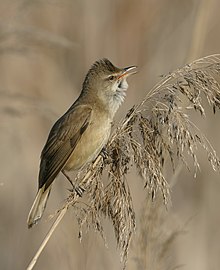
Back Acrocephalus (voël) Afrikaans هازجة Arabic هازجه ARZ Drozbeka (Acrocephalus) AVK Чаротаўкі Byelorussian Чаротаўкі BE-X-OLD Rouzegan Breton Boscarla Catalan Acrocephalus CEB Acrocephalus Danish
| Acrocephalus | |
|---|---|

| |
| Great reed warbler, Acrocephalus arundinaceus | |
| Scientific classification | |
| Domain: | Eukaryota |
| Kingdom: | Animalia |
| Phylum: | Chordata |
| Class: | Aves |
| Order: | Passeriformes |
| Family: | Acrocephalidae |
| Genus: | Acrocephalus J. A. Naumann and J. F. Naumann, 1811 |
| Type species | |
| Turdus arundinaceus[1] Linnaeus, 1758
| |
| Species | |
|
See text | |
The Acrocephalus warblers are small, insectivorous passerine birds belonging to the genus Acrocephalus. Formerly in the paraphyletic Old World warbler assemblage, they are now separated as the namesake of the marsh and tree warbler family Acrocephalidae. They are sometimes called marsh warblers or reed warblers, but this invites confusion with marsh warbler and reed warbler.
These are rather drab brownish warblers usually associated with marshes or other wetlands. Some are streaked, others plain. Many species breeding in temperate regions are migratory.
This genus has heavily diversified into many species throughout islands across the tropical Pacific. This in turn has led to many of the resulting insular endemic species to become endangered. Several of these species (including all but one of the species endemic to the Marianas and two endemic to French Polynesia) have already gone extinct.
The most enigmatic species of the genus, the large-billed reed warbler (A. orinus), was rediscovered in Thailand in March, 2006; it was found also in a remote corner of Afghanistan in the summer of 2009. Prior to these recent sightings, it had been found only once before, in 1867.
- ^ "Acrocephalidae". aviansystematics.org. The Trust for Avian Systematics. Retrieved 2023-07-15.